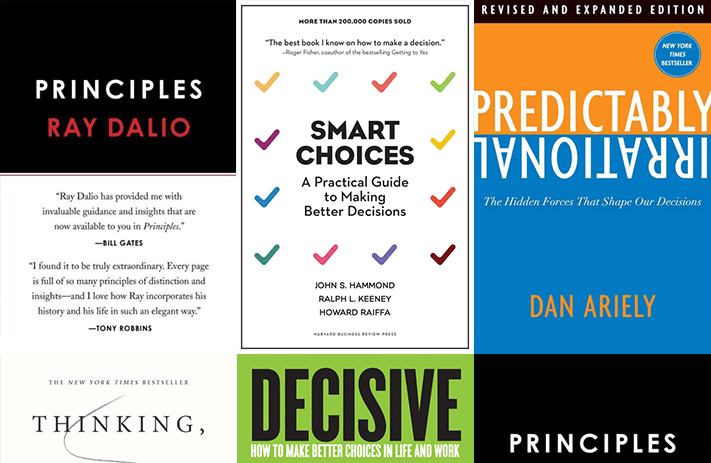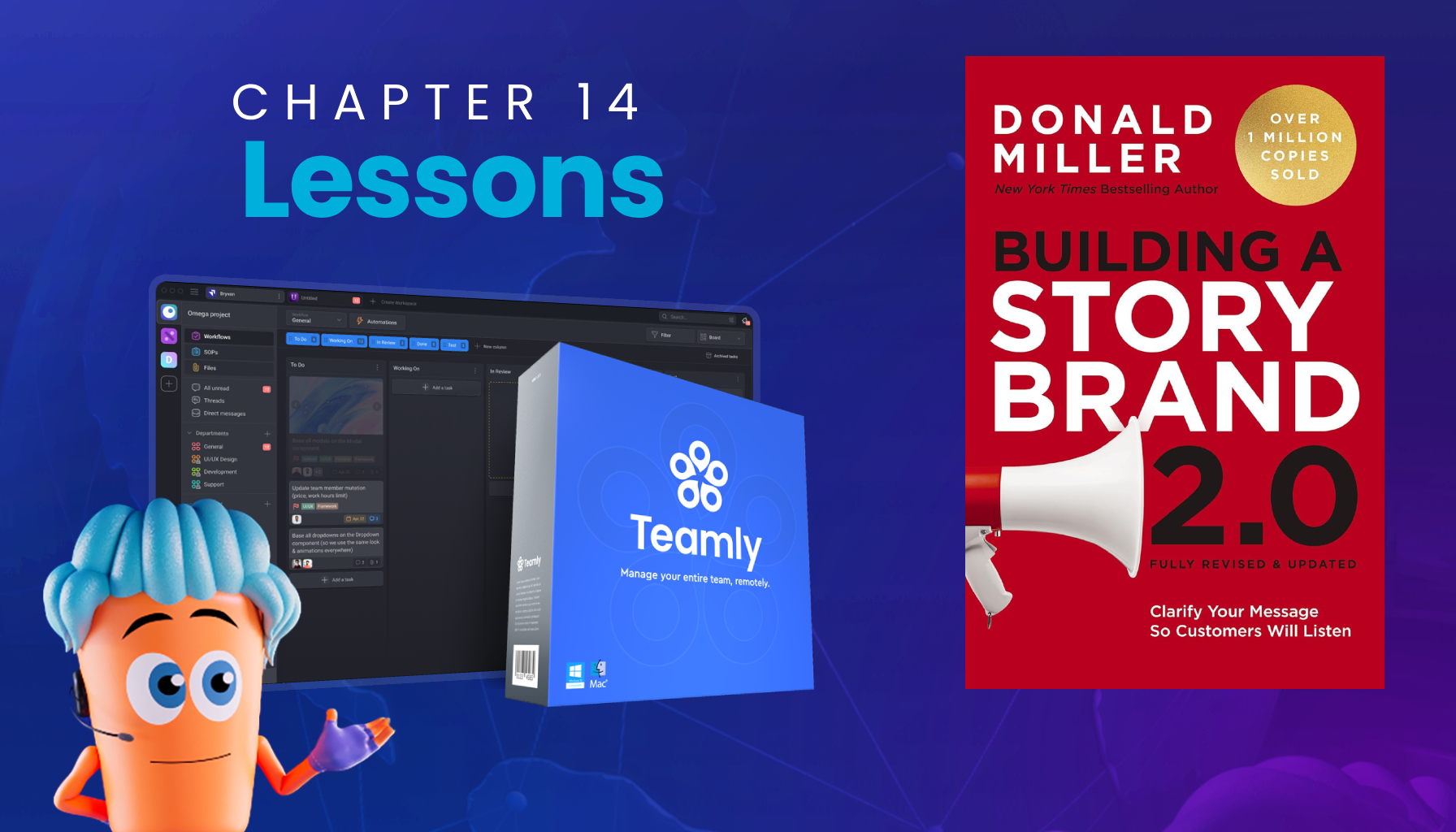
Click the button to start reading
The Top 5 Books For Decision Making: Decision Making Tools For Project Managers
Making decisions is one of the most important skills a project manager can possess. Being able to make decisions quickly and efficiently is essential. If you can’t do that, your projects are likely to fail.
There are a lot of books out there that claim to be able to help you improve your decision-making skills. But which ones are worth reading?
To help out, We’ve put together a list of the best books for decision-making. These books will teach you everything from how to make decisions under pressure, to how to avoid decision-making traps.
So, if you’re looking to improve your decision-making skills, be sure to check out these five books for making decisions. These are the best books project managers can utilize to learn how to make smart choices.
1. Principles
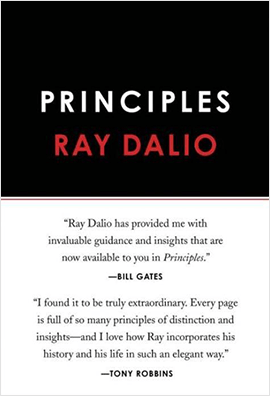 Author: Ray Dalio
Author: Ray Dalio
Publication date: 2017
In Principles, Dalio lays out his decision-making framework, in a comprehensive and easily digestible manner.
For Dalio, principles are fundamental truths that serve as the foundations for behavior. They’re not just something you think about, they drive your actions and get results.
Principle-driven people don’t just have principles, they live by them. And when the going gets tough or if you’re not sure about which direction to take next in life – these principles function as guiding lights to help lead you with confidence and clarity.
What’s great about Dalio’s book is that he provides insights and stories from his own life to illustrate how these decision-making principles have helped him achieve success both in his personal and professional life.
Five Step Process
His five-step process for getting what you want out of life is particularly useful for project managers who are looking to grow.
Step one is to create clear goals.
This might seem like a no-brainer, but it’s important to be clear about what you want before you can start taking steps to achieve it. So be sure to narrow down and prioritize your goals before moving on to the next step. Project managers have to do it every day.
The second step is to recognize and avoid the problems that get in the way of your objectives.
Again, this is something that project managers are all too familiar with. There are always going to be obstacles in your way, but it’s important to identify them and find ways to work around them.
The problems in your way are screaming for you to fix them. Don’t make the mistake of thinking that the cause of the problem is the real problem. Find out what is causing the problem, and then you can work on fixing it.
The third step is to accurately diagnose the problems you’re facing.
This is where a lot of people make mistakes because they don’t take the time to understand the problem before trying to solve it. You need to take a step back and really analyze the situation before taking action. Otherwise, you run the risk of making the situation worse or even creating new problems.
The fourth step is to design creative solutions that get results.
This is where your creativity and decision-making skills come into play. You need to find solutions that are outside the box and that will actually get results.
The fifth and final step is to implement your solutions with discipline and determination.
Once you’ve designed your solutions, it’s time to put them into action. This is where a lot of people fail because they lack the discipline to see their plans through. It’s not enough to just have a great idea, you need to be able to execute it and optimize it.
2. Thinking Fast and Slow
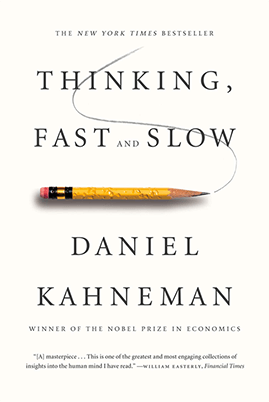 Author: Daniel Kahneman
Author: Daniel Kahneman
Year of Publication: 2011
Daniel Kahneman is a psychologist Israeli-American awarded the 2002 Nobel Prize in Economics Science. In his book, Thinking Fast and Slow, Kahneman explores the two systems of thought that guide the decision-making process: System One (fast) and System Two (slow).
System one is fast, intuitive, and emotional. It’s the part of your brain that responds quickly to gut instinct or snap judgments.
System two is slower, more deliberate, and more logical. It’s the part of your brain that you use when you’re solving complex problems or making calculations.
Thinking Fast and Slow argues that most decision-making is done by System One thinking, while System Two thinking is reserved for more difficult tasks. Nevertheless, it’s important to be aware of both systems and how they work in order to make the best decisions possible.
System one is fast, but it’s not always accurate.
System two is slower, but it’s more likely to result in a correct decision.
The key is to use both systems of thought and weigh your options before making a decision.
The best decision-makers are those who are able to use both system one and system two thinking. They’re able to quickly identify the problems and then take the time to accurately diagnose them before finding creative solutions. If you want to improve your decision-making skills, this book is a must-read.
3. Decisive
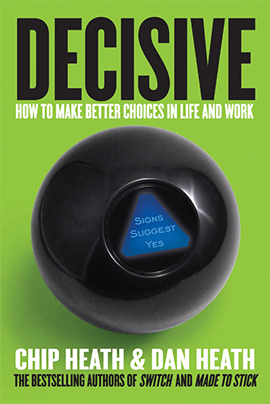 Author: Chip Heath and Dan Heath
Author: Chip Heath and Dan Heath
Year of Publication: 2013
Chip and Dan Heath are brothers and business professors at Stanford University. In their book, Decisive, they explore the decision-making process and offer a framework for making better choices. The first step is to understand your ” decision-making style.”
Four biases can lead to bad decision-making: narrow framing, confirmation bias, short-term emotion, and over-confidence. The first step to making better decisions is to be aware of these biases and learn how to avoid them.
The Heath brothers show us the process in a very straightforward way. The decisions you make in your life are often highjacked by hidden forces that make your thinking move towards cognitive biases.
The process of decision-making is not always logical. It often unfolds irrationally.
- At first, you’ll be presented with a decision. However, narrow framing prevents you from considering other viable alternatives.
- Then you evaluate your choices. The confirmation bias, on the other hand, leads you to collect biased data.
- Then you make a choice. You decide what you want to do. However, short-term emotions more often than not persuade you to make the incorrect selection.
- Then you live with it. But overconfidence bias often leads you to ignore feedback that should make you question your decision.
The Heath brothers introduce a process called “WRAP.” The WRAP process is a decision-making framework that helps you avoid making decisions based on biases. The acronym stands for: Widen your options, reality-test your assumptions, attain distance before deciding, and prepare to be wrong. This process can help you make better decisions by giving you time to think about the situation and all of the possible outcomes.
If you’re looking for a book that will help improve your decision-making skills, then I highly recommend Decisive. It offers a great framework for avoiding cognitive biases by improving your ability to operate in systemic thinking that aims at deeper understanding.
4. Predictably Irrational
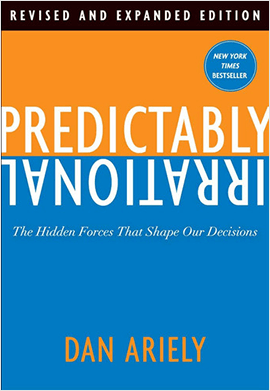 Author: Dan Ariely
Author: Dan Ariely
Year of Publication: 2008
People usually think they are making smart, rational decisions when they are making choices. But according to Duke University professor Dan Ariely, that is not usually the case. In his book, Predictably Irrational, he explores the hidden forces that shape our decision-making.
Ariely starts with a simple premise: The decisions we make are not always rational. Often, they’re driven by emotions and biases that we’re not even aware of.
A great example to illustrate this would be to look at a coffee shop. The decision to buy a coffee might seem like a simple and rational choice. But when you take a closer look, you’ll realize that many hidden biases influence our decision.
Ariely explains how there are invisible forces that drive our decision-making. And they often lead us to make choices that are not in our best interest.
Some of these irrational drivers include social norms, sunk costs, anchoring, and loss aversion.
Ariely has a lot of research to back up what he’s saying and shares some pretty interesting stories from his own life and everyday experience to illustrate his points. In the end, he offers hope that we can learn to overcome our faults and make better decisions with the help of systems that take our irrationality into account.
5. Smart Choices
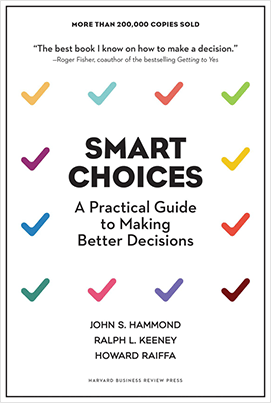 Authors: John S. Hammond, Ralph L. Keeney, and Howard Raiffa
Authors: John S. Hammond, Ralph L. Keeney, and Howard Raiffa
Year of Publication: 1999
The decision-making process is a topic that has been studied extensively by academics and business professionals alike. And there are a lot of different methods out there for making decisions.
One popular method is called “smart choice.” It’s a decision-making process that was developed by three decision-making experts: John S. Hammond, Ralph L. Keeney, and Howard Raiffa.
The goal of the smart choice method is to help you make decisions that are both effective and efficient. In other words, it’s supposed to help you make the best possible decision with the resources you have available.
The smart choice process has 8 Elements
- Problem – To make the best decision, you need to be clear about the problem you are trying to solve. You also need to be aware of how complex the problem is and avoid making assumptions or limiting your options.
- Objectives – You should always have a goal in mind when making a decision. This will help you stay on track and achieve what you want. Make sure that your objectives reflect your interests, values, and concerns. This will help make sure that your decisions are in line with what you want to accomplish.
- Alternatives – You have to choose from different courses of action. If you don’t have different alternatives, you won’t be able to make a decision. But have you considered all the alternatives or at least a wide range of them? Remember: your decision can be no better than your best alternative.
- Consequences – Think about what could happen if you choose a particular alternative. How well does that alternative meet all of your objectives? Alternatives are tempting, but they often have serious consequences. Being honest about the consequences of each alternative will help you pick the one that best meets all your objectives.
- Tradeoffs – You will need to make some tradeoffs when you are trying to meet multiple objectives. This is because they often conflict with each other. You can’t have everything, so you will need to choose what is most important to you. Look at the different alternatives and see which one meets the most of your objectives.
- Uncertainty – When you are making a decision, it is important to think about what could happen in the future. You need to think about how likely it is that each thing will happen, and how bad the outcome would be if it did. This way, you can make a better decision.
- Risk Tolerance – Think about how much risk you are willing to take. When making decisions, sometimes the outcome you want might not be the one that happens. Knowing how much risk you are willing to take will help you make better decisions because you will be more aware of the risks involved.
- Linked Decisions – When making a decision, it’s important to think about how that choice will affect future decisions. Your goals for the future should influence the decision you make today. This is called a “linked decision.” The key to dealing with linked decisions is to deal with near-term issues first, while gathering information needed to decide the future. By taking steps that will let you learn as much as possible, you can make better choices, even in an uncertain world.
Psychological traps
There’s another category of errors called psychological traps. These are mental shortcuts that our brain takes to save time and energy. The problem is, that these mental shortcuts often lead us astray.
The Anchoring Trap:
When making a decision, the mind often gives more weight to the first information it receives. This is because it takes less effort to process. As a result, we often end up “anchoring” on that first piece of information and not considering other options.
The Sunk Trap:
There’s a tendency to throw good money after bad. This is because we have a hard time accepting that we’ve made a mistake. We often rationalize our decision by telling ourselves “we’ve already invested so much, we can’t stop now.”
Status Quo Trap:
We, humans, are creatures of habit. We like things to stay the same and resist change. This is because change can be scary and uncertain. As a result, we often stick with the status quo, even when it’s not in our best interest.
The Confirming-Evidence Trap:
When we’re presented with evidence that goes against our beliefs, we tend to discount it or explain it away. This is because it’s threatening to our worldview and the way we see ourselves. The confirming-evidence trap can affect where we go to find evidence and how we interpret the evidence we do find. This can lead us to give too much weight to information that supports our view and too little weight to information that conflicts with it.
The Recallability Trap:
People usually think about the chances of something happening based on their past experiences. Sometimes, people are influenced by how dramatic an event is. This can be a problem because sometimes we remember these events more clearly than others. People might also be influenced by things that have happened to them in their own life, which can distort their thinking.
The Outguessing Randomness Trap:
We often think we can see patterns in random events. This is because our brains are wired to look for patterns. The problem is, that sometimes these patterns don’t exist. We might see a pattern where there is none, or we might miss a pattern that is there.
Summary
Making decisions can be hard for a plethora of reasons. You might be presented with too many options, you might be considering the future, or you might be worried about making a mistake. However, by understanding some of the common traps that people fall into when making decisions, you can avoid them and make better choices.
The best books for decision-making are those that address the specific problems of decision paralysis, linked decisions, and psychological traps. These books can help you become a better project manager by teaching you how to make better decisions and avoid common traps.
These are just a few of the many great books out there on decision-making. You can’t go wrong with any of them, but hopefully, this list will get you started on your journey to becoming a better decision-maker. Thanks for reading!

